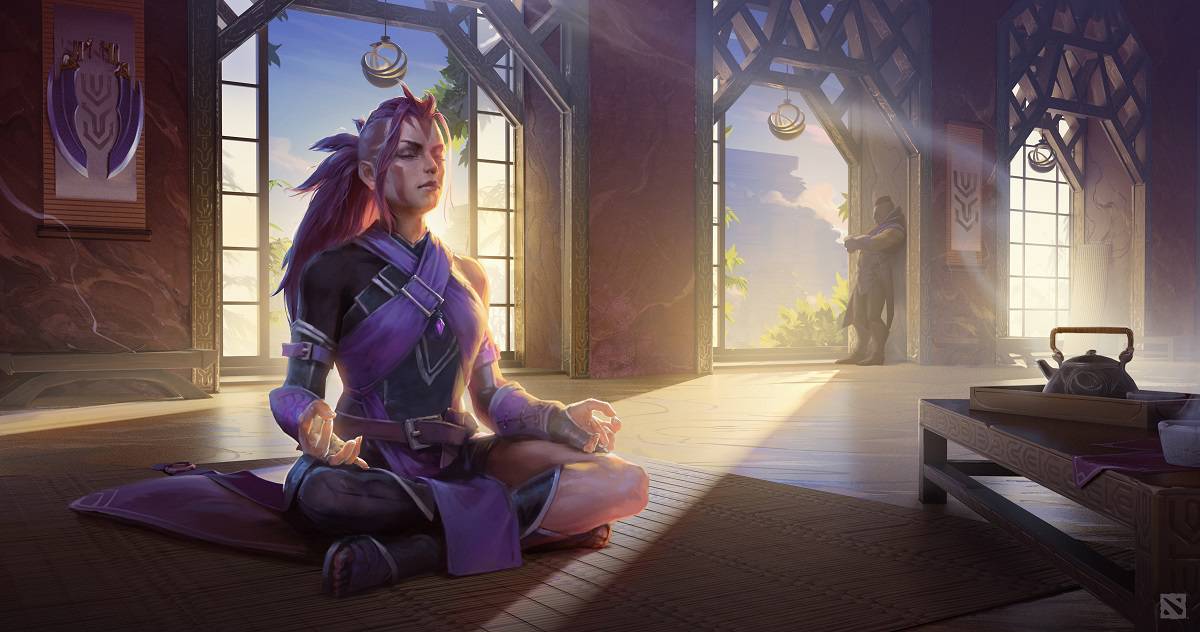Attribute Bonus — a Mechanic Long Forgotten

One of the more interesting developments for Dota over the last five years is how attributes have more or less made a full circle. After multiple attempts to make primary attributes more meaningful and tie other game mechanics to Strength, Agility and Intelligence, we are now back to the very basics. We are not here to discuss whether this simplicity is beneficial or not, but rather remind players that there is one mechanic that recently made a comeback as a result of this approach that is quite underrated.
Using a skill point into Attribute Bonus seems counter-intuitive, wasteful, and ineffective. It is, after all, only 40 extra HP, 2 extra Damage and Attack Speed, and 24 extra Mana. There is some extra Armor, as well as HP and Mana regen, but these are mostly trivial.
Why would any hero go for this, as opposed to having more skills or better skills? There is only one answer: efficiency.
BURNING ANTI-MAGE
Some of our newer players might not know who Burning is, so as a quick reference: Xu  Aster.BurNIng Zhilei was the carry player at the dawn of Dota. Much like contemporary Arteezy, back in the day he was considered to be the most mechanically skilled carry player in the world with great game sense on top. And he was the creator of a pretty interesting Anti-Mage build that was the default go-to for many years.
Aster.BurNIng Zhilei was the carry player at the dawn of Dota. Much like contemporary Arteezy, back in the day he was considered to be the most mechanically skilled carry player in the world with great game sense on top. And he was the creator of a pretty interesting Anti-Mage build that was the default go-to for many years.
1-1-1-1 and several points into Attribute Bonus for the early levels is not something you will see these days, but back in the day it allowed Burning Anti-Mage to get ahead by a large margin. More Mana Burn or Magic Resistance don’t do anything for the hero who wants to push in waves and farm for 25+ minutes, while extra attributes not only increase farming speed but also provide an extra layer of protection if and when AM gets ganked.
We strongly advise against the 1-1-1-1 approach these days for one simple reason: Blink cooldown. It was increased substantially early in the 7.xx era and the 15-second cooldown at level one is way too restrictive. That said, looking at the guides page for the hero, we can see that several high-level players do opt for 2-4-1-1 build early on and then take one or two levels of attributes, before maxing out other abilities.
This makes a lot of sense since you don’t always need extra mana burn, especially when playing against targets with an already limited mana pool. You don’t always need a low-cooldown Counterspell either. But the 40-120 extra health can be a difference-maker on a hero who is all about EHP. Anti-Mage has a lot of armor and built-in Magic Resistance, but his Strength growth is rather low even after the buffs, so there isn’t a lot of actual HP to turn into Effective HP.
Keep that in mind the next time you play Anti-Mage: avoiding even one death because you had a modicum of extra health can be a game-changer, given how Anti-Mage is all about outpacing the enemy.
THE PUB JUGG
There is a massive difference between how Juggernaut is played in pubs and in the pro-scene. It feels like the latter is mostly about Healing Ward and sometimes about built-in Spell Immunity to avoid or counteract spells like Mars Arena or Supernova. For that reason we most often see professional players max out Bladefury first, Healing Ward second with a value point in Blade Dance.
In pubs, where farming efficiency, survivability, and scaling usually take priority over early team pressure, the opposite build is more common: value point in Healing Ward, with a heavy focus on Blade Dance as the second skill to max out.
Now, what we might want to argue for and what we’ve seen several high-level pub players do is a 4-1-1-1 build with a heavy focus on stats afterward. This is not a professional-grade build and that should be understood: only maxed out Healing Ward into -20 second cooldown on Healing Ward talent at level 15 is considered professionally viable, because if you want damage and scaling you usually go carries other than Juggernaut, at least in a professional setting. But the 4-1-1-1 is a pretty efficient pub build for several reasons.
Value point in Blade Dance is non-negotiable: it is, on average, a 16% increase in damage. Every point afterward is an extra +4%, going 16/20/24/28% extra damage. While the end result is pretty impressive, the point-by-point increase is not that huge, if we consider several factors.
Juggernaut deals a lot of damage through Bladefury without actually hitting his enemies. Extra Health, Armor and, most importantly, Mana are a bigger deal on Juggernaut, compared to other carries.
His second highest damage output source is usually Omnislash, which scales incredibly well with both extra Damage and extra Attack Speed. Extra two agility you get from Attribute Bonus translate into extra AS, which is more effective on Juggernaut, compared to other carries, because of his lower innate BAT and because there is an extra AS multiplier on Omnislash.
In fact, at level 12, Omnislash deals almost the exact same amount of damage, on average, with three points in attributes compared to three extra points into maxed out Blade Dance.
Tested on level 12 Jugg with Phase Boots, Magic Wand, Maelstrom, and Yasha — the most common buildup by level 12 among pub Juggernauts.
However, the 4-1-1-1 also gives Juggernaut extra 120 HP, 72 Mana, and 1 Armor. While we are at it, do not hesitate to comment on why no one builds Power Treads on Juggernaut. It doesn’t make sense in the pro-scene, for obvious reasons, but in pubs, where end-game DPS is usually more important than tempo, Power Treads outclass Phase Boots by a huge margin, because of the Attack Speed multiplication discussed earlier. Moreover, Juggernauts usually build gap-closers such as Agh’s or Swift Blink anyways, making MS less of an issue.
VOID, UNDILUTED
Time Dilation is among the most exciting new additions to the game, in our opinion. This addition was so strong that some teams even tried to play the hero as a support, though we can’t say it was very consistent or successful. Despite that, in the current meta we will actually argue towards leaving Time Dilation as a value point in the absolute majority of your games, getting extra stats instead.
Maxed out Time Walk and maxed out Time Lock are non-negotiable: they are your primary source of survivability and damage respectively. Time Dilation, on the other hand, scales in a pretty interesting manner. It’s cooldown decreases massively, but it still stays at a value where it is far from spammable and usually far from being useful as a “twice-in-a-fight” kind of spell.
The duration increase on it also doesn’t make a ton of sense: it is one extra second per level, but there is very little difference between eight and eleven seconds, in the context of a single teamfight. Same goes for damage: extra one damage per level per cooldown makes a difference pretty much in only one scenario: a fully “spent” Invoker. In every other case, it is trivial.
What is not trivial is the Mana Cost increase. Ten extra Mana per level might not sound like a lot, but we are talking about Faceless Void and his 1.5 Intelligence per level. Losing ten extra mana per cast for no apparent gain, in our opinion, is strictly inferior to having extra 24 mana from attribute boost. That is without considering all the other benefits it provides.
As is everything Dota, there are many theoretical scenarios where this is not true and there are games where you want Time Dilation maxed out, but we are sure that these scenarios are extremely rare. Faceless Void needs a little extra to not get overwhelmed in the early midgame and it is the reason players most often skip the level ten talent and sometimes even the level two ultimate, in favor of stats.